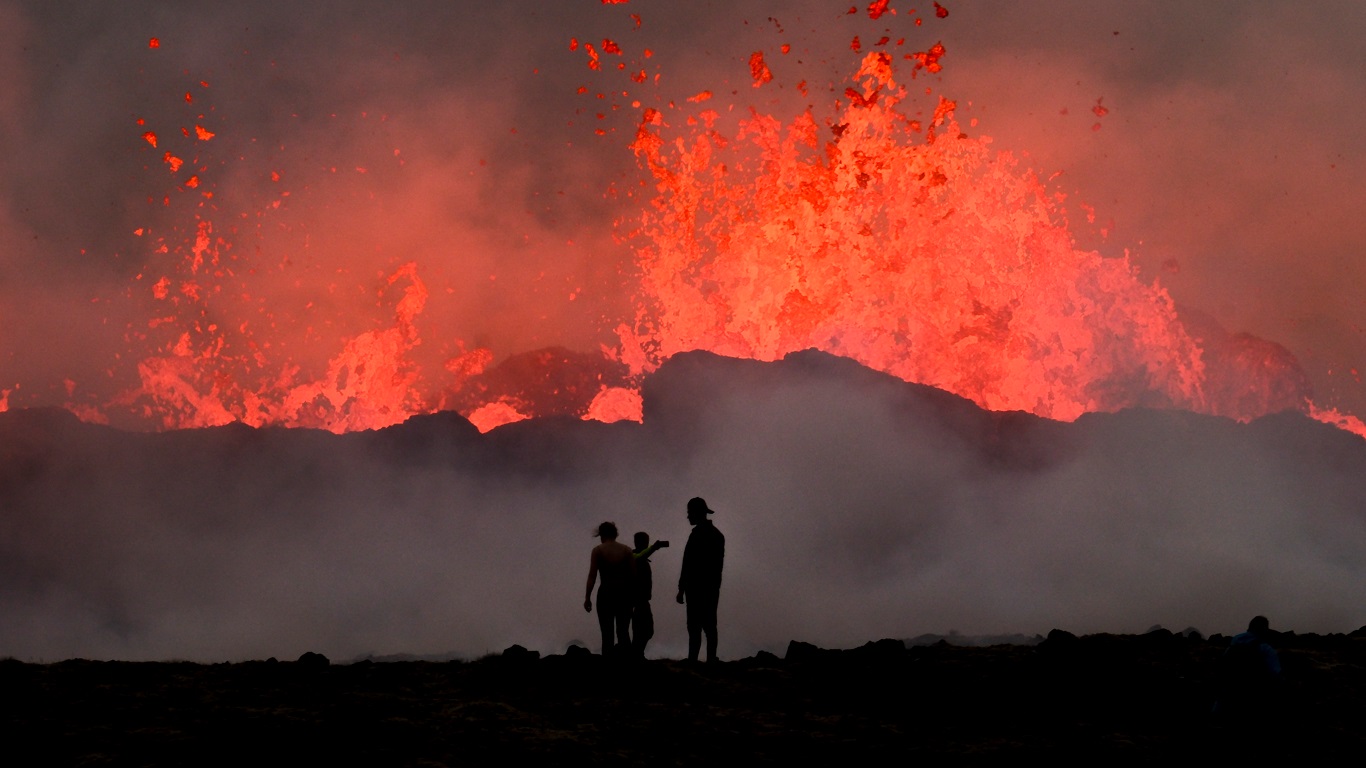Lava flows during a volcanic eruption near Litli Hrutur, southwest of Reykjavik, Iceland, on July 10, 2023. The peninsula near the capital has seen significant volcanic activity in recent years, resulting in a notable movement of tourists to the country. | Kristin Magnusson/AFP/Metsol Meteorology
Iceland declared a state of alert in anticipation of an imminent volcanic eruption preceded by a large wave of earthquakes near the capital, Reykjavik. Some of the strongest earthquakes could be felt in the capital on Friday, raising the alert level of Icelandic authorities, who fear an eruption larger than those that have occurred in recent years.
This impressive video comes from #GrindavikThe key point is the intense seismic sequence in the Corso in question or in Isla. I started to quickly fall asleep but never settled into action. Reading vengono avvertite practically in continuous mode. pic.twitter.com/EYx0RCUWpG
– Il Mondo di Teremoti (@mondoterremoti) November 10, 2023
A wave of hundreds of earthquakes, including two with a magnitude greater than 5.0 and at least seven with a magnitude of 4.5, rocked Iceland’s Reykjanes Peninsula on Friday near the capital. The so-called “seismic swarm” indicates a local volcanic eruption in the coming hours or days, prompting the Icelandic Meteorological Office to declare a state of emergency.
The Fagradalsfjall volcano is located in the southern region of the Icelandic Peninsula, about 40 kilometers southwest of Reykjavik, the country’s capital. Several earthquakes shook the city and the famous Blue Lagoon geothermal resort in Grindavik was closed. It was initially unclear whether Vagradalsfjall was responsible for the increased seismic activity or whether it was an eruption occurring elsewhere in the Reykjanes volcanic system.
Before midnight local time, all residents of Grindavik were warned to leave the city. The Meteorological Authority warned of the possibility of volcanic fissures opening near or inside the city. “Based on the development of seismic activity since 6 p.m. today, combined with the results of GPS measurements, there is a possibility that a magma seep has extended beneath Grindavik,” the office wrote.
Experts believe that the molten dam may have formed directly under the city. Dikes are layers of magma that flow through existing fractures in the rock or generate a new fissure. The largest volcanoes can contain hundreds of dykes.
A code orange – or level 3 of 4 on the global warning scale for terrestrial volcanoes – was declared, raising concerns at Keflavik International Airport, which lies northwest of the seismically active zone.
The region has witnessed intermittent eruptions since 2021, but the eruption that could start at any time is likely to be more intense. “The amount of magma present is much greater than that observed in the largest magma seeps associated with the volcanic eruptions at Fagradalsfjall,” officials said.
The government warned on Friday afternoon that the quakes were occurring about three kilometers northeast of Grindavik, with fault slips occurring about three to three kilometers underground. The quakes struck the community of 3,300 people at sunset.
Civil Protection Department @manavarner Decided to order #evacuation to #Grindavik Given the uncertainty of where #eruption it will happen. All citizens must leave the area immediately. For information about the evacuation plan – please visit the website https://t.co/zB7y1wjHiw #Rykjanis pic.twitter.com/AxN69rEXQa
– Gisli Olafsson (@gislio) November 10, 2023
“The seismic activity moved south towards Grindavik,” the Met Office said. “The signs that can be seen now… are similar to those observed on the eve of the first eruption in Fagradalsfjall in 2021, and are very similar to the seismic activity measured about a month before that eruption,” the office warned in a statement. Previous update.
Previously, it was estimated that it would take several days for the magma to reach the surface and the impending eruption would begin. The earthquake has already torn up roads. There was up to three inches of uplift, or vertical movement of the ground, near the volcano.
The Reykjanes Peninsula in Iceland has been hit by more than a thousand earthquakes in the past 24 hours alone due to rising magma. The roads are even starting to open up. The town of Grindavik is under an evacuation order as fears grow of a volcanic eruption. pic.twitter.com/WkWxTwemrW
– Collin Gross (@CollinGrossWx) November 11, 2023
Although Iceland is tectonically and volcanically active, the area around the Fagradalsfjall volcano remained inactive for more than 6,300 years, until December 2019. At that time, the peninsula was rocked by a series of earthquakes, including two with a magnitude of 5.6. Then, on February 4, 2021, a 5.7 magnitude earthquake caused minor damage to homes. Six weeks later, on March 19, the volcano erupted, creating a fissure about 600 meters long and spewing lava.
The fissure was later named Geldingadalsgos, representing a potential new shield volcano – a broad volcano with gently sloping sides – and attracted widespread tourism. Several other cracks opened in April, but only one remains active as of May 2021.
Another fissure eruption, separate from Fagradalsfjall, occurred on August 3, 2022. Last summer, in early July, a new eruption began near Letli-Hrotor, also part of the Fagradalsfjall volcano. The eruption was about 10 times larger than the first two and subsided on August 5.

“Music fanatic. Professional problem solver. Reader. Award-winning tv ninja.”






More Stories
Couple retakes glacier photo after 15 years, surprised by changes: ‘It made me cry’
Two killed in hotel collapse in Germany – DW – 07/08/2024
Lula speaks for half an hour on phone with Biden about Venezuela’s electoral impasse | Politics